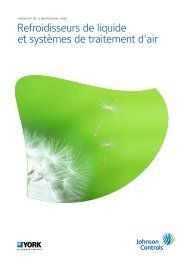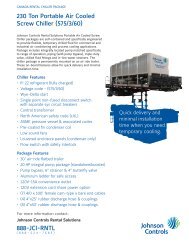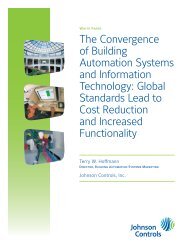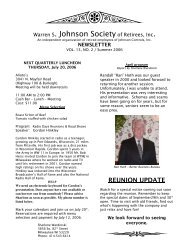Rxf - Johnson Controls Inc.
Rxf - Johnson Controls Inc.
Rxf - Johnson Controls Inc.
You also want an ePaper? Increase the reach of your titles
YUMPU automatically turns print PDFs into web optimized ePapers that Google loves.
When changing the coalescer filter element, it is recommended<br />
that the oil and oil filter be changed. Applicable<br />
strainer elements should be removed and cleaned.<br />
1. Refer to CHANGING OIL, Steps 1 thru 8.<br />
2. Remove coalescer head and gasket. Discard the gasket.<br />
3. Remove and retain nut securing coalescer filter retainer.<br />
4. Remove retainer, coalescer filter element(s), and two<br />
O-rings. Discard the filter element(s).<br />
5. Install new coalescer filter element(s). NOTE: Frick SuperCoalescer<br />
element (with drain feature), on Models 24–101, must<br />
be installed with the "DRAIN DOWN" tag on the bottom at the<br />
6 o'clock position.<br />
Seat element in center of locating<br />
tabs on separator bulkhead.<br />
6. Replace coalescer filter retainer and nut. Tighten the nut<br />
to 21 ft/lb torque. DO NOT OVERTIGHTEN NUT. Excessive<br />
torque can damage the element and result in oil carryover.<br />
Install jam nut and tighten.<br />
7. Install a new head gasket and replace the coalescer head.<br />
8. Tighten the head bolts, first to finger tight, then 65 ft-lb,<br />
then 130 ft-lb. NOTE: WHEN THE COM PRES SOR UNIT IS<br />
REPRESSURIZED, RETIGHTEN SINCE HEAD BOLTS WILL<br />
LOOSEN.<br />
9. Refer to CHANGING OIL, Steps 9 thru 14.<br />
CHANGING OIL<br />
DO NOT MIX OILS of different<br />
brands, manufacturers, or types.<br />
Mixing of oils may cause excessive<br />
oil foaming, nuisance oil level cutouts, oil pressure loss,<br />
gas or oil leakage and catastrophic compressor failure.<br />
Shut down the unit when changing oil. At the same time all<br />
oil filter cartridges must be changed and all oil strainer elements<br />
removed and cleaned. The procedure is as follows:<br />
1. Push [STOP] key to shut down the unit.<br />
2. Open disconnect switch for the compressor motor starter.<br />
3. Close liquid injec tion service valves (if applicable).<br />
4. Close discharge service valve. SLOWLY vent the separator<br />
to low-side system pres sure using the suction check valve<br />
bypass. Close suction valve. NOTE: Recover or transfer all<br />
refrigerant vapor, in accordance with local ordinances,<br />
before opening to atmosphere. The separator MUST be<br />
equalized to atmospheric pressure.<br />
Oil entrained refrigerant may vaporize,<br />
causing a separator pressure<br />
increase. Repeat venting and recovery<br />
procedure, if neces sary.<br />
5. Open drain valve(s) located on the underside of the separator<br />
and drain the oil.<br />
6. Drain oil filter, strainers, and oil cooler, if applicable.<br />
7. Remove and install new oil filter element.<br />
8. Remove, clean, and reinstall strainer ele ments in strainers.<br />
9. Evacuate unit to 29.88" Hg (1000 microns).<br />
RXF ROTARY SCREW COMPRESSOR UNITS<br />
MAINTENANCE<br />
070.410-IOM (JUL 11)<br />
Page 25<br />
10. Open suction service valve and pressurize the unit to<br />
system suction pressure. Close the suction valve and leak test.<br />
11. Add oil by attaching a suitable pressure-type hose to<br />
the oil drain valve located on top of the separator. Using a<br />
pressure-type oil pump and recommended Frick oil, open the<br />
drain valve and fill the separator until oil level is midway in<br />
the top sight glass. NOTE: Evacuation of the oil separator<br />
will assist the flow of oil into the unit. Also, fill slowly<br />
because oil will fill up in the separator faster than it shows<br />
in the sight glass. See Oil Charge section.<br />
12. Open discharge and liquid injec tion service valves.<br />
13. Close disconnect switch for compressor motor starter.<br />
14. Start the unit.<br />
SUCTION STRAINER CLEANING PROCEDURE<br />
1. Open disconnect switch.<br />
2. Isolate the package by closing all package valves to the<br />
system. Tag all closed valves.<br />
Open any solenoid valves or other<br />
valves that may trap liquid<br />
between the isolation valves and<br />
other package valves to prevent injury or damage to<br />
components.<br />
3. With liquid injection, close the manual hand valve upstream<br />
of YY7 and manually open YY7 by turning in the manual<br />
opening stem (clockwise viewed from below valve).<br />
Failure to follow this procedure will<br />
damage valve YY7.<br />
4. SLOWLY vent the separator to low-side system pressure<br />
using the suction check valve bypass. NOTE: Recover or<br />
transfer all refrigerant vapor, in accordance with local<br />
ordinances, before opening to atmosphere. The separator<br />
MUST be equalized to atmospheric pressure.<br />
Oil entrained refrigerant may vaporize,<br />
causing a separator pressure<br />
increase. Repeat transfer and recovery<br />
procedure, if necessary.<br />
5. Remove cover plate.<br />
6. Remove strainer.<br />
7. Clean strainer.<br />
8. Reinstall the strainer in the proper direction (outboard<br />
end is marked) and replace the gasket.<br />
If the strainer is installed backwards,<br />
it will be damaged.<br />
9. Pressurize and leak test. Evacuate unit to 29.88" Hg (1000<br />
microns).<br />
10. First, reset solenoid valves to automatic position then<br />
open all valves previously closed. Remove tags. Close disconnect<br />
switches for compressor. Start unit.










![[PDF] Intelligent Fire Annunciator IFA-1000 - Johnson Controls Inc.](https://img.yumpu.com/7424420/1/190x245/pdf-intelligent-fire-annunciator-ifa-1000-johnson-controls-inc.jpg?quality=85)





